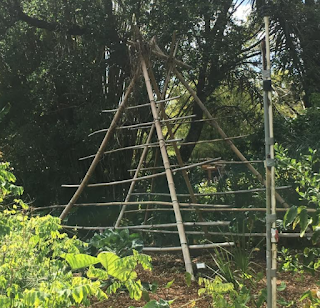Echo and the Food Footprint
Last week saw the class take a trip to the ECHO Farm, an organization that aims to help feed people around the globe. ECHO stands for the Educational Concerns for Hunger Organization, and they have a few impact center locations in areas like Africa and Asia. By exploring different farming techniques around the world, EHCO spreads this knowledge to help equip people in impoverished areas with the tools necessary to sustain a food source. On our trip to this location, we took a tour around the farm to explore some of these intuitive designs that have been thought up throughout their existence as an organization.
Entrance to ECHO Farm
There are close to a billion people living on the planet at this instance who are suffering from hunger complications, even more disturbing is the fact that a child dies from hunger almost every twelve seconds. Many people around the world do not have access to high end grocery stores or even a simple market which they can go to buy food. A good percentage of people farm for themselves and their families and must sustain themselves off the crop which they grow. Another statistic which I was made aware of is that the average (small-scale) farmer can only produce enough food to sustain half of his family.
Educational Signs like this were scattered around the farm
When analyzing which crops a farmer should focus on growing, it is worth noting that about 75% of the world's food is generated from only twelve unique crops and five animals. Looking at smaller scale farmers, about 90% of crop variety have vanished, how could this be? Well, as land space diminishes with an ever growing population and natural disasters plague the lands; the tools necessary to grow these crops as well as the land to grow them on are ever dwindling. There must be some new ways to utilize what these farmers have in order to maximize growth.
One way to farm in a crowded city area that ECHO has promoted is called Urban Gardening. By utilizing the roofs of high rises and houses, the amount of land that can be farmed is almost tripled. It is intuitive ideas like this which makes ECHO such a driving factor in changing the lives of many around the world.
A visualization of 'Urban Gardening'
Another interesting concept that ECHO uses, is to plant alternatives to some common crops to better suit your conditions. The Katuk plant, known as the leaf vegetable or sweet leaf, is a plant that can thrive in shade or poor conditions. It can tolerate soils that are not nutrient rich, as well as non-rainy/rainy conditions. It is truly a marvel which can survive in a number of different biomes. Plants like this are utilized by ECHO as they are known to be sustainable in even the poorest of conditions.
A visualization of the Katuk
Although we were introduced to a bunch of new concepts in ECHO Farm, I cannot say that any of them apply to my life. I do appreciate the lengths to which ECHO has gone to promote the feeding of people around the globe, and it is an issue I can get behind. However, in this era of technology on the western hemisphere I cannot say that I can apply these concepts to my every day life, as interesting as they all are. This trip did get me thinking, what if I had to grow my own food to survive? I think that would be a humbling experience, and provide a much closer relationship to the food I eat than I know have. Perhaps it would provide me with a greater appreciation for some things we take for granted on a daily basis.






Comments
Post a Comment